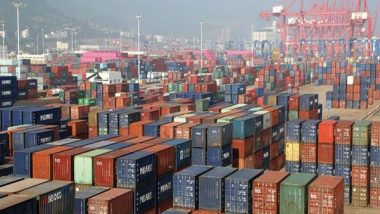New Delhi, January 31: India is well on track to achieve a merchandise export target of 400 billion US dollars in 2021-22 after the pandemic-induced slump of the previous year, with strong capital flows into India leading to a rapid accumulation of foreign exchange reserves, according to the Economic Survey 2021-22 released on Monday.
The annual survey report tabled in Parliament by Finance Minister Nirmala Sitharaman noted that the resilience of India's external sector during the current year augurs well for growth revival in the economy.
It, however, cautions that the downside risks of global liquidity tightening and continued volatility of global commodity prices, high freight costs, coupled with the fresh resurgence of COVID-19 with the new variants may pose a challenge for India during 2022-23.
The survey states that owing to the recovery of global demand coupled with a revival in domestic activity, India's merchandise exports and imports rebounded strongly and surpassed pre-COVID levels during the current financial year.
Also Read | Bengaluru: Youth Gets Shock of His Life, Finds Own Video With Girlfriend on Porn Sites.
The revival in exports was also helped by timely initiatives taken by the Government. The USA followed by the UAE and China remained the top export destinations in April-November, 2021, while China, the UAE and the USA were the largest import sources for India.
Despite weak tourism revenues, there was a significant pickup in net services receipts during April-December, 2021 on account of robust software and business earnings, with both receipts and payments crossing the pre-pandemic levels.
The Economic Survey notes that the first half of the calendar 2021 witnessed an acceleration in the global economic activity that lifted the merchandise trade above its pre-pandemic peaks.
It says that India's merchandise exports have followed the global trend and during April - December 2021 the merchandise exports grew by 49.7 per cent, compared to the corresponding period of last year and 26.5 per cent over 2019-20 (April-December).
The survey mentions that India has already attained more than 75 per cent of its ambitious export target of $400 billion set for 2021-22, and is well on the track to achieve the target.
It says that sharp recovery in key markets, increased consumer spending, pent-up savings and disposable income due to the announcement of fiscal stimulus by major economies, and an aggressive export push by the Government have bolstered exports in 2021-22.
The rise in exports has been broad-based. India's agriculture exports continue to do well, with the export of agriculture and allied products growing by 23.2 per cent during April-November 2021 over the corresponding period of last year. The Survey recommends that a push in the direction of Free Trade Agreements would help provide the institutional arrangements for India's exports diversification.
On the issue of merchandise imports, the Economic Survey states that India witnessed a revival in domestic demand resulting in strong import growth. Merchandise imports grew at the rate of 68.9 per cent in April-December, 2021 over the corresponding period of last year and 21.9 per cent over April-December 2019, crossing the pre-pandemic level.
The survey indicates that there has been increased diversification of India's import sources as reflected in the reduction of China's share to 15.5 per cent from 17.7 per cent in the April-November period. The Survey indicates that the merchandise trade deficit has increased to $142.4 billion in April-December 2021.
India has maintained its impressive performance in world services trade in the post-COVID-19 period, with services exports growing by 18.4 per cent to $177.7 billion during April-December 2021 for the corresponding period of last year. The Survey says that the strong growth witnessed in services exports may also be attributed to key reforms undertaken by the Government.
Services imports rose by 21.5 per cent to $103.3 billion in April-December 2021.
The Economic Survey says that India's current account balance turned into a deficit of 0.2 per cent of GDP in the first half of 2021-22, largely led by a deficit in the trade account. Net capital flows were higher at $65.6 billion in the first half of 2021-22, on account of continued inflow of foreign investment, revival in net external commercial borrowings (ECBs), higher banking capital and additional special drawing rights (SDR) allocation.
India's external debt rose to $593.1 billion at the end of September 2021, from $556.8 billion a year earlier, reflecting additional SDR allocation by IMF, coupled with higher commercial borrowings.
(This is an unedited and auto-generated story from Syndicated News feed, LatestLY Staff may not have modified or edited the content body)













 Quickly
Quickly




















